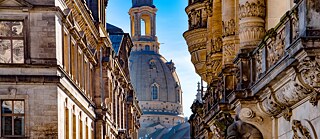Dresden has a reputation for being a bit too baroque, stuffy, and reserved. But the Saxon capital has another different side that is modern, alternative, and surprising. Our author Kaddi Cutz reveals the multiple facets of the Florence on the Elbe and overhauls a cliché or two.
A magic cauldron of colour
 Magical moments at Dresden’s Schaubuden Summer fair.
| Photo (detail): © picture alliance/ZB/Britta Pedersen
Every year in July, the rear courtyard of the Scheune cultural centre in the trendy Neustadt district fills with magic for an enchanted, sometimes surreal and candy-coloured fair full of wonderful oddities, fluffy cotton candy and a wizardry all its own. Jugglers, dancers, musicians and jesters stroll amid the many small stalls that offer all kinds of whimsical, but also wistfully or eerily beautiful treasures for the culturally savvy bargain hunter. Entertainers come from all over the world to surprise guests for eleven nights of special and ever-changing performances and attractions. Dresden residents who embody their hometown’s bourgeois cliché run up against another side of the city here. Each Schaubuden Summer evening ends with a “midnight surprise”: concerts from a private balcony, puppet theatre in the park and much more. The Schaubuden Summer is a dazzling mixture of glitter and glamour, of circus and theatrical make-up, amazement and comprehension – a unique summer night’s dream no one should sleep through.
Magical moments at Dresden’s Schaubuden Summer fair.
| Photo (detail): © picture alliance/ZB/Britta Pedersen
Every year in July, the rear courtyard of the Scheune cultural centre in the trendy Neustadt district fills with magic for an enchanted, sometimes surreal and candy-coloured fair full of wonderful oddities, fluffy cotton candy and a wizardry all its own. Jugglers, dancers, musicians and jesters stroll amid the many small stalls that offer all kinds of whimsical, but also wistfully or eerily beautiful treasures for the culturally savvy bargain hunter. Entertainers come from all over the world to surprise guests for eleven nights of special and ever-changing performances and attractions. Dresden residents who embody their hometown’s bourgeois cliché run up against another side of the city here. Each Schaubuden Summer evening ends with a “midnight surprise”: concerts from a private balcony, puppet theatre in the park and much more. The Schaubuden Summer is a dazzling mixture of glitter and glamour, of circus and theatrical make-up, amazement and comprehension – a unique summer night’s dream no one should sleep through.
An ostentatious view open to all
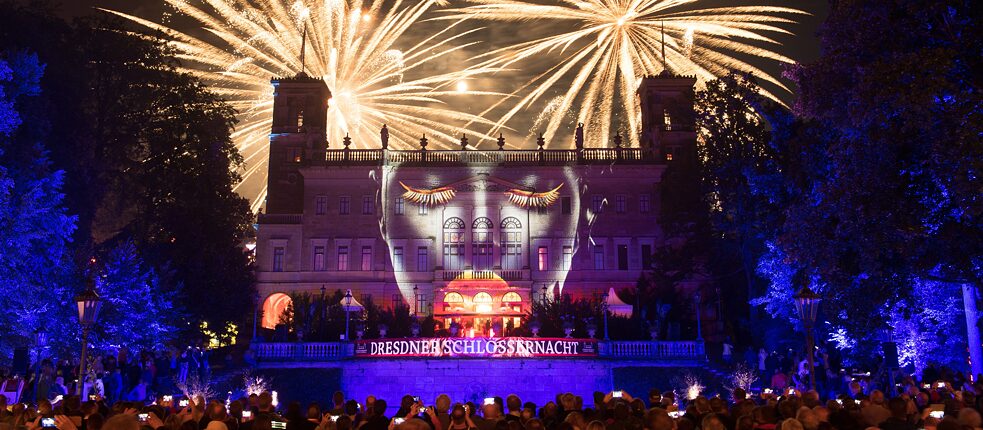 Nightly highlight: During Castle Night, artists perform in the parks of the Albrechtsberg, Eckberg and Lingner castles.
| Photo (detail): © picture alliance/dpa/dpa-Zentralbild/Sebastian Kahnert
Lingner Castle offers one of the most beautiful views of the Elbe valley and the city of Dresden nestled in it. Together with fellow Eckberg and Albrechtsberg castles, this magnificent late classicist building forms the trio commonly known as “The Elbe Castles”. All three survived World War II without a hit, which borders on a minor miracle since most of Dresden’s baroque buildings fell victim to the bombs. While Eckberg and Albrechtsberg are largely closed to the public – the former is now primarily a hotel, the latter a sought-after wedding venue and location for events like the annual “Dresden (Er)Lesen” book fair – Lingner Castle met a different fate. Initially built for Prince Albrecht of Prussia, today the castle bears the name of the man who bought it in 1906: Karl-August Lingner, an entrepreneur, patron of the arts, manufacturer and enthusiastic proponent of Odol mouthwash. He lived in the castle for ten years before dying from oral cavity carcinoma of all things in 2016. Lingner bequeathed the castle to the city of Dresden with the express condition that the property always be accessible to all citizens and not just the well-heeled upper class and include a restaurant with affordable prices. To this day, guests at the beer garden and restaurant enjoy a view that stretches for miles over the vineyards all the way to the Czech Republic in good weather – and can partake in a rotating alcoholic beverage at the bargain price of 0.75 euros. Since 2002, the Förderverein Lingnerschloss association has worked on restoring the estate and providing space for culture. Some rooms are now open again for exhibitions, film screenings, wedding ceremonies and cultural events. Looking down from his fresh-breathed cloud, Lingner is surely pleased.
Nightly highlight: During Castle Night, artists perform in the parks of the Albrechtsberg, Eckberg and Lingner castles.
| Photo (detail): © picture alliance/dpa/dpa-Zentralbild/Sebastian Kahnert
Lingner Castle offers one of the most beautiful views of the Elbe valley and the city of Dresden nestled in it. Together with fellow Eckberg and Albrechtsberg castles, this magnificent late classicist building forms the trio commonly known as “The Elbe Castles”. All three survived World War II without a hit, which borders on a minor miracle since most of Dresden’s baroque buildings fell victim to the bombs. While Eckberg and Albrechtsberg are largely closed to the public – the former is now primarily a hotel, the latter a sought-after wedding venue and location for events like the annual “Dresden (Er)Lesen” book fair – Lingner Castle met a different fate. Initially built for Prince Albrecht of Prussia, today the castle bears the name of the man who bought it in 1906: Karl-August Lingner, an entrepreneur, patron of the arts, manufacturer and enthusiastic proponent of Odol mouthwash. He lived in the castle for ten years before dying from oral cavity carcinoma of all things in 2016. Lingner bequeathed the castle to the city of Dresden with the express condition that the property always be accessible to all citizens and not just the well-heeled upper class and include a restaurant with affordable prices. To this day, guests at the beer garden and restaurant enjoy a view that stretches for miles over the vineyards all the way to the Czech Republic in good weather – and can partake in a rotating alcoholic beverage at the bargain price of 0.75 euros. Since 2002, the Förderverein Lingnerschloss association has worked on restoring the estate and providing space for culture. Some rooms are now open again for exhibitions, film screenings, wedding ceremonies and cultural events. Looking down from his fresh-breathed cloud, Lingner is surely pleased.
Dresden’s fabulous prefab
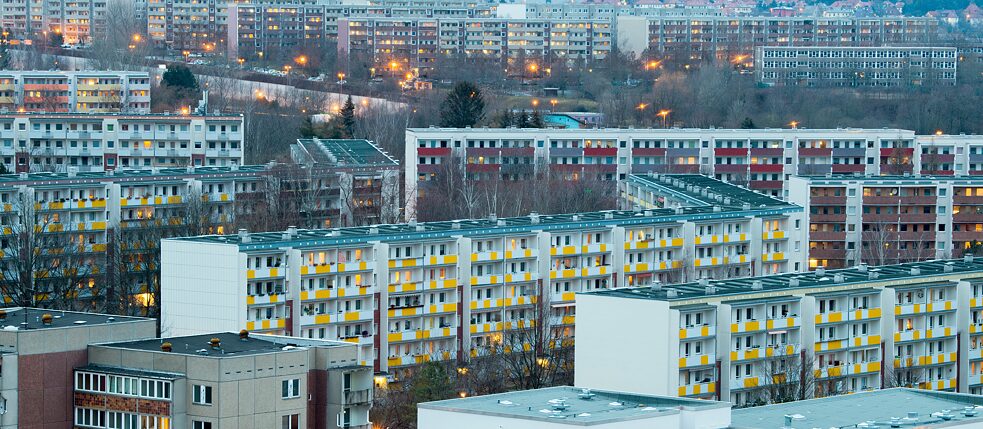 Dresden is working on upgrading its prefabricated housing estates.
| Photo (detail): © picture alliance/dpa-Zentralbild/Monika Skolimowska
Dresden might have a reputation for the baroque, but it is so much more. Prefabricated housing estates boomed here in the 1960s and the tall tower blocks of flats became the epitome of East German modernism. And while it might have been hip to be square, the constructions lacked flair. After the Berlin Wall fell, demand also dropped drastically and the housing estates once considered so chic increasingly developed into hotspots of social unrest. Since then, the “Platte”, short for the German word “Plattenbau” or “slab building” used to describe this kind of prefab tower block housing, has become a synonym for social decline and the poster child for an ugly living environment. But this does not have to be the case, as the Kräutersiedlung in Gorbitz has shown. Once a village with farms, half-timbered houses and fields, the Dresden district of Gorbitz had a quite literal concrete legacy to deal with following reunification. The SED politburo had chosen it as a site for a prefab housing estate comprising several thousand flats. Over the years, the Dresdner Eisenbahner Wohnungsgenossenschaft (EWG) housing corporation took a few runs at upgrading the city’s largest housing estate. In 2002, the time had finally come: the EWG began dismantling one or two upper storeys on the six-storey towers, enlarging and adding windows to kitchens and bathrooms, and building new balconies. Everything was modernized, given a new coat of paint, and surrounded by lots of greenery. Today, life between the streets of Kamillenweg and Thymianweg is so beautiful and contemporary that another conversion project has already been launched in Gorbitz.
Dresden is working on upgrading its prefabricated housing estates.
| Photo (detail): © picture alliance/dpa-Zentralbild/Monika Skolimowska
Dresden might have a reputation for the baroque, but it is so much more. Prefabricated housing estates boomed here in the 1960s and the tall tower blocks of flats became the epitome of East German modernism. And while it might have been hip to be square, the constructions lacked flair. After the Berlin Wall fell, demand also dropped drastically and the housing estates once considered so chic increasingly developed into hotspots of social unrest. Since then, the “Platte”, short for the German word “Plattenbau” or “slab building” used to describe this kind of prefab tower block housing, has become a synonym for social decline and the poster child for an ugly living environment. But this does not have to be the case, as the Kräutersiedlung in Gorbitz has shown. Once a village with farms, half-timbered houses and fields, the Dresden district of Gorbitz had a quite literal concrete legacy to deal with following reunification. The SED politburo had chosen it as a site for a prefab housing estate comprising several thousand flats. Over the years, the Dresdner Eisenbahner Wohnungsgenossenschaft (EWG) housing corporation took a few runs at upgrading the city’s largest housing estate. In 2002, the time had finally come: the EWG began dismantling one or two upper storeys on the six-storey towers, enlarging and adding windows to kitchens and bathrooms, and building new balconies. Everything was modernized, given a new coat of paint, and surrounded by lots of greenery. Today, life between the streets of Kamillenweg and Thymianweg is so beautiful and contemporary that another conversion project has already been launched in Gorbitz.
Classical instead of a cool brew
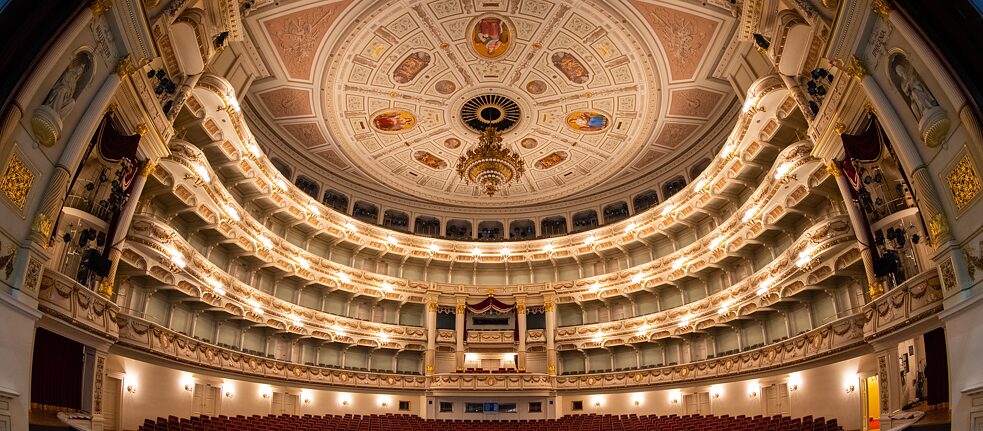 Inside the Semper Opera House.
| Photo (detail): © picture alliance/dpa/dpa-Zentralbild/Robert Michael
Because the Radeberger beer brand once featured the Semper Opera House a little too prominently in an advertising spot, tourists are still sometimes a little surprised that the magnificent building created by Gottfried Semper offers cultural rather than hop-based entertainment. The Semper Opera House is not a brewery, of course, but one of the most famous music venues in the world and draws a crowd for more than just the annual Semper Opera ball. The opera house on Theaterplatz square is already on its third encore – the first building fell victim to a fire in 1869 and the reconstruction to an air raid in 1945. Forty years later, the current Semper Opera opened its doors and has staged roughly 250 performances a year since. Anyone who prefers architecture to song can take a guided tour of the magnificent interior and learn that beer was, in fact, involved in the reconstruction. The artificial wood panelling in the foyer owes its natural-looking hue to a dunking in the cold, frothy brew.
Inside the Semper Opera House.
| Photo (detail): © picture alliance/dpa/dpa-Zentralbild/Robert Michael
Because the Radeberger beer brand once featured the Semper Opera House a little too prominently in an advertising spot, tourists are still sometimes a little surprised that the magnificent building created by Gottfried Semper offers cultural rather than hop-based entertainment. The Semper Opera House is not a brewery, of course, but one of the most famous music venues in the world and draws a crowd for more than just the annual Semper Opera ball. The opera house on Theaterplatz square is already on its third encore – the first building fell victim to a fire in 1869 and the reconstruction to an air raid in 1945. Forty years later, the current Semper Opera opened its doors and has staged roughly 250 performances a year since. Anyone who prefers architecture to song can take a guided tour of the magnificent interior and learn that beer was, in fact, involved in the reconstruction. The artificial wood panelling in the foyer owes its natural-looking hue to a dunking in the cold, frothy brew.
A cat’s kingdom
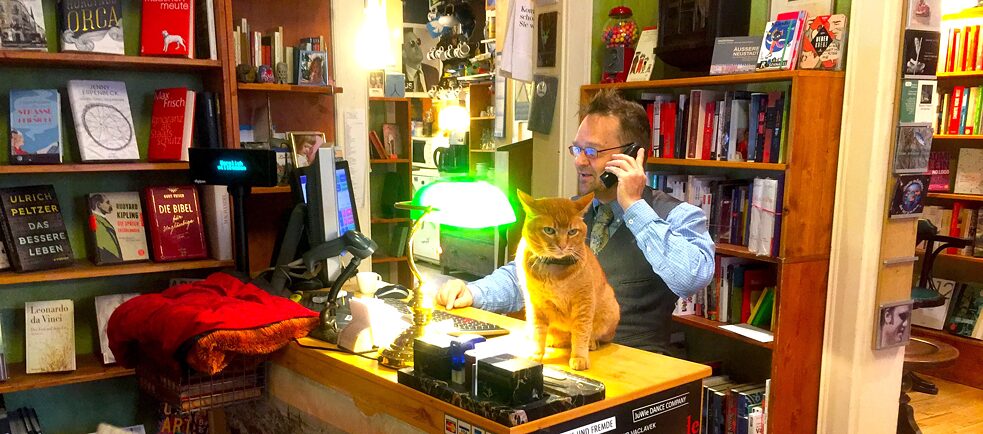 A cat is the behind-the-scenes boss of Dresden’s cult bookstore Bücher’s Best: store cat Myamoto Musashi with Jörg Stübing or “Stü”.
| Photo (detail): © Kaddi Cutz
A cat serves as the behind-the-scenes boss of Dresden’s cult bookstore, Bücher’s Best. Store feline Myamoto Musashi keeps an unblinking, critical eye on all the goings-on and sometimes offers a furry paw for a bookworm struggling to make the best choice to hold. Run by Jörg Stübing known as Stü, who studied philosophy and fell into book dealing kind of by accident, the store is a ream gem. It brings people who would otherwise have little overlap together to engage in animated shop talk and spontaneous recitations. It is not a place to meet up with Dresden’s more tight-lipped residents, even if the carefully cultivated and varied selection might leave you speechless. Every book has been selected for a reason and recommendations are almost always on the money. An entire shelf features tomes from small publishers and local authors and it is not uncommon for them to drop in to pass the time with a chat or to pet the cat before reading from their work or taking part in a poetry slam. After hours, Stü also regularly opens the Louisenstraße store for exhibitions, concerts and readings, which take place outdoors in the garden in summer.
A cat is the behind-the-scenes boss of Dresden’s cult bookstore Bücher’s Best: store cat Myamoto Musashi with Jörg Stübing or “Stü”.
| Photo (detail): © Kaddi Cutz
A cat serves as the behind-the-scenes boss of Dresden’s cult bookstore, Bücher’s Best. Store feline Myamoto Musashi keeps an unblinking, critical eye on all the goings-on and sometimes offers a furry paw for a bookworm struggling to make the best choice to hold. Run by Jörg Stübing known as Stü, who studied philosophy and fell into book dealing kind of by accident, the store is a ream gem. It brings people who would otherwise have little overlap together to engage in animated shop talk and spontaneous recitations. It is not a place to meet up with Dresden’s more tight-lipped residents, even if the carefully cultivated and varied selection might leave you speechless. Every book has been selected for a reason and recommendations are almost always on the money. An entire shelf features tomes from small publishers and local authors and it is not uncommon for them to drop in to pass the time with a chat or to pet the cat before reading from their work or taking part in a poetry slam. After hours, Stü also regularly opens the Louisenstraße store for exhibitions, concerts and readings, which take place outdoors in the garden in summer.
Soul food for cinema buffs
 An art house cinema in the Blasewitz district is the address for European film l’auteur, documentaries and unsung gems of the silver screen.
| Photo (detail): © PK Ost
Programmkino Ost is a must if you are into rare film treasures. The independent art house cinema in the Blasewitz district is the premiere address for European film l’auteur, documentaries, and unsung gems of the silver screen. Operators Jana Engelmann and Sven Weser only show films they deem worth watching – a formula for success for over two decades now. Word has spread, and up to 180,000 film buffs come from all around the region to where restored stucco meets state-of-the-art cinema technology to fully scratch their cinematic itch.
An art house cinema in the Blasewitz district is the address for European film l’auteur, documentaries and unsung gems of the silver screen.
| Photo (detail): © PK Ost
Programmkino Ost is a must if you are into rare film treasures. The independent art house cinema in the Blasewitz district is the premiere address for European film l’auteur, documentaries, and unsung gems of the silver screen. Operators Jana Engelmann and Sven Weser only show films they deem worth watching – a formula for success for over two decades now. Word has spread, and up to 180,000 film buffs come from all around the region to where restored stucco meets state-of-the-art cinema technology to fully scratch their cinematic itch.
The ancient tree
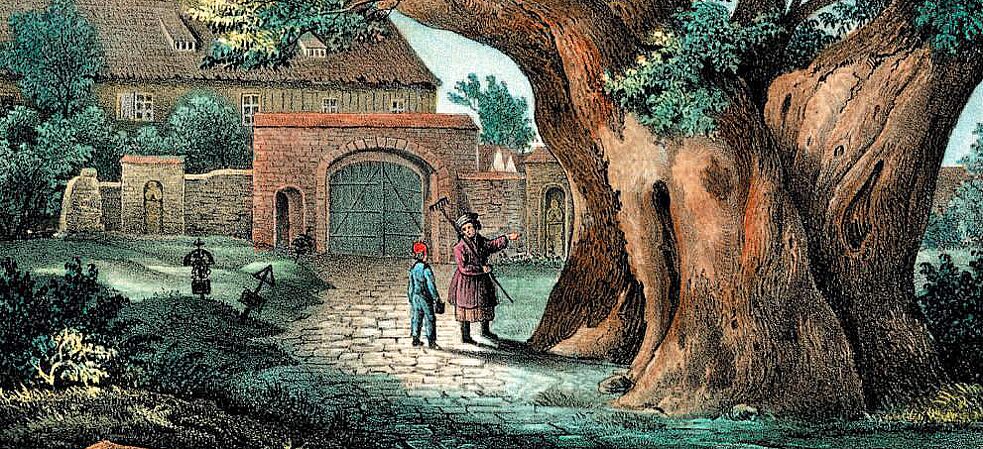 “The large linden tree in the churchyard at Kaditz”: Lithograph by Carl Wilhelm Arldt (c. 1840).
| Photo (detail): © Wikipedia.org/Gemeinfrei
Anyone looking to tour historic villages in Dresden should follow an easy rule of thumb: any place with the prefix “alt” or “old” is a good spot to see some old things. Whether it is Alt-Trachau, Altpeischen or Altkötzschenbroda (strictly speaking not really Dresden anymore, but too lovely to be excluded), these picturesque villages with their four-cornered courtyards, farmhouses and craftsmen’s houses are like a trip back in time. Altkaditz, for example, is home to the “thousand-year-old” in Emmaus churchyard. Experts have estimated the huge linden tree in front of the 300-year-old rectory of the Laurentius Lutheran congregation to be at least 850 years old, making it the oldest tree in Dresden. It is around 20 meters high and the circumference of its oddly shaped trunk is about half that. The linden was damaged when fire swept through the village in 1818, splitting the trunk in two, which grew back together in an unusual shape. The interior is hollow and held together with supports, but a new layer of bark has formed inside over the decades. The Kaditz linden tree was declared a national monument in 1985.
“The large linden tree in the churchyard at Kaditz”: Lithograph by Carl Wilhelm Arldt (c. 1840).
| Photo (detail): © Wikipedia.org/Gemeinfrei
Anyone looking to tour historic villages in Dresden should follow an easy rule of thumb: any place with the prefix “alt” or “old” is a good spot to see some old things. Whether it is Alt-Trachau, Altpeischen or Altkötzschenbroda (strictly speaking not really Dresden anymore, but too lovely to be excluded), these picturesque villages with their four-cornered courtyards, farmhouses and craftsmen’s houses are like a trip back in time. Altkaditz, for example, is home to the “thousand-year-old” in Emmaus churchyard. Experts have estimated the huge linden tree in front of the 300-year-old rectory of the Laurentius Lutheran congregation to be at least 850 years old, making it the oldest tree in Dresden. It is around 20 meters high and the circumference of its oddly shaped trunk is about half that. The linden was damaged when fire swept through the village in 1818, splitting the trunk in two, which grew back together in an unusual shape. The interior is hollow and held together with supports, but a new layer of bark has formed inside over the decades. The Kaditz linden tree was declared a national monument in 1985.
Strength comes from the centre
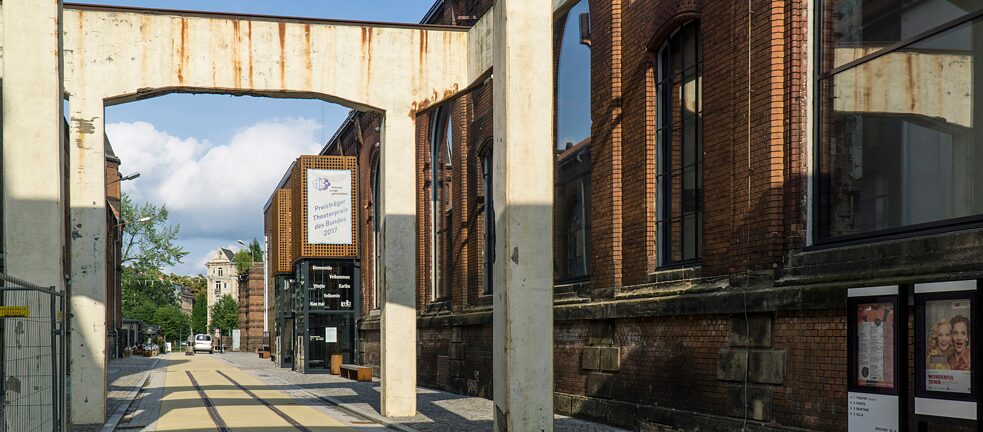 The tig. theater junge generation and the Staatsoperette have found new homes in a former power plant, Kraftwerk Mitte.
| Photo (Detail): © picture alliance/Bildagentur-online/Exss
Backward-looking, stuck in the old ways, not open to new things – these attributes are often used in connection with Dresden. Kraftwerk Mitte, however, gives the lie to all these accusations. The massive, 40,000-square-meter industrial monument from the 19th century has become a unique, vibrant hotspot for art, culture and the creative industries. Once a combined heat and power plant in the Wilsdruffer Vorstadt district, it was decommissioned in 1944 and started its second chapter as a cultural venue in 2016. The Dresden State Operetta independent opera house has found a new home here, as has the tjg. theater junge generation (Theatre for the Young Generation). Right next door, you can party at the Kraftwerk Mitte event location, watch fine films at the Zentralkino cinema, and advance your knowledge at Energy Museum and the Academy of Music. Kraftwerk Mitte is also a real architectural highlight. Several buildings from the industrial era, some registered cultural monuments, are flanked by some new buildings. The conversion into a cultural centre won the 2017 Saxon State Prize for Baukultur.
The tig. theater junge generation and the Staatsoperette have found new homes in a former power plant, Kraftwerk Mitte.
| Photo (Detail): © picture alliance/Bildagentur-online/Exss
Backward-looking, stuck in the old ways, not open to new things – these attributes are often used in connection with Dresden. Kraftwerk Mitte, however, gives the lie to all these accusations. The massive, 40,000-square-meter industrial monument from the 19th century has become a unique, vibrant hotspot for art, culture and the creative industries. Once a combined heat and power plant in the Wilsdruffer Vorstadt district, it was decommissioned in 1944 and started its second chapter as a cultural venue in 2016. The Dresden State Operetta independent opera house has found a new home here, as has the tjg. theater junge generation (Theatre for the Young Generation). Right next door, you can party at the Kraftwerk Mitte event location, watch fine films at the Zentralkino cinema, and advance your knowledge at Energy Museum and the Academy of Music. Kraftwerk Mitte is also a real architectural highlight. Several buildings from the industrial era, some registered cultural monuments, are flanked by some new buildings. The conversion into a cultural centre won the 2017 Saxon State Prize for Baukultur.
Bring a brolly
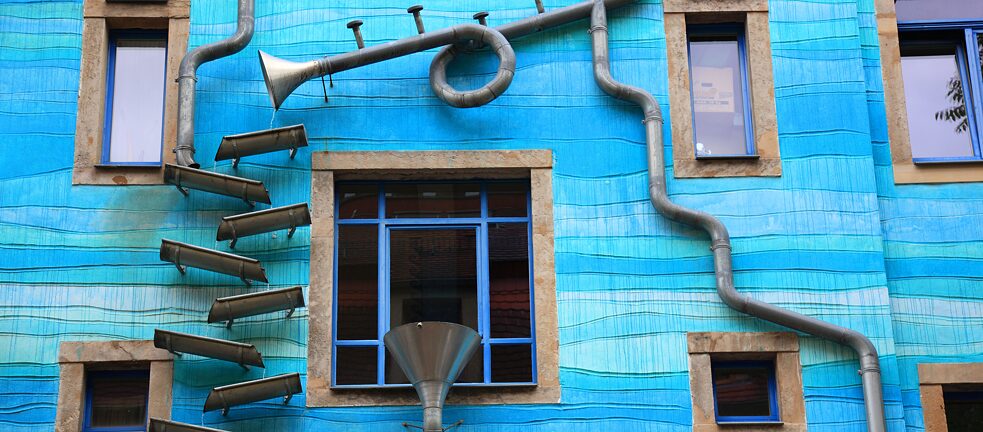 Courtyard of Elements in Dresden’s Kunsthofpassage.
| Photo (detail): ©picture alliance/Bildagentur-online/Sunny Celeste
There is no need for rain to dampen your spirits in Dresden. Especially in the Kunsthofpassage, a chain of several elaborately designed courtyards in Dresden’s Neustadt district, where rain regularly provides entertainment. In the “Courtyard of Elements,” the drainpipes create their own music against the backdrop of a bright blue façade. The practical work of art was a joint effort by sculptor Annette Paul and designers Christoph Roßner and André Tempel. When it rains in the trendy neighbourhood, the rainwater runs through a sophisticated labyrinth of pipes, funnels, trumpets, waterfalls and platforms before collecting in a basin. On the way down, it creates an ever-changing melody. Do not forget your umbrella though if you want to enjoy the watery concert in comfort. Otherwise, you can sit dry, but not high and dry, in the neighbouring courts of Light, Metamorphoses, Animals or Mythical Creatures, with all their playful and hidden details and extraordinary stores.
Courtyard of Elements in Dresden’s Kunsthofpassage.
| Photo (detail): ©picture alliance/Bildagentur-online/Sunny Celeste
There is no need for rain to dampen your spirits in Dresden. Especially in the Kunsthofpassage, a chain of several elaborately designed courtyards in Dresden’s Neustadt district, where rain regularly provides entertainment. In the “Courtyard of Elements,” the drainpipes create their own music against the backdrop of a bright blue façade. The practical work of art was a joint effort by sculptor Annette Paul and designers Christoph Roßner and André Tempel. When it rains in the trendy neighbourhood, the rainwater runs through a sophisticated labyrinth of pipes, funnels, trumpets, waterfalls and platforms before collecting in a basin. On the way down, it creates an ever-changing melody. Do not forget your umbrella though if you want to enjoy the watery concert in comfort. Otherwise, you can sit dry, but not high and dry, in the neighbouring courts of Light, Metamorphoses, Animals or Mythical Creatures, with all their playful and hidden details and extraordinary stores.
The nerve centre
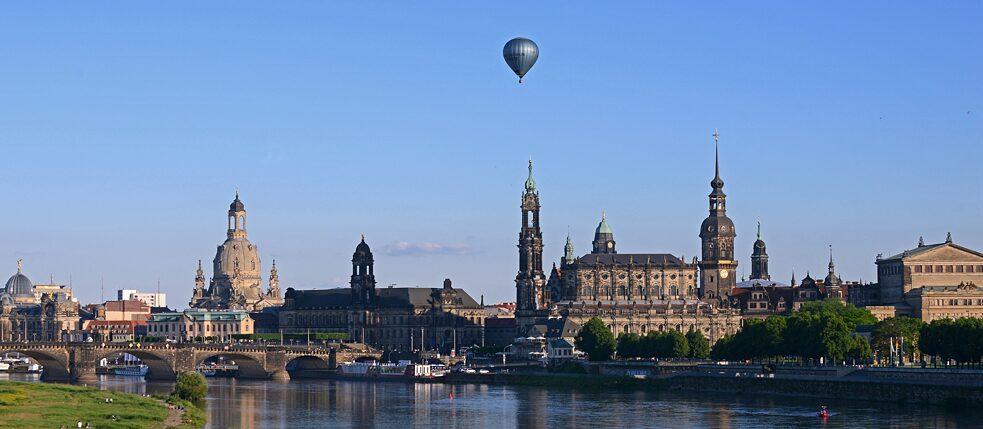 Everything in Dresden’s old town centre is in walking distance.
| Photo (detail): © picture alliance/Matthias Hiekel/dpa
While it might not seem particularly innovative to tout a downtown as a place of interest, it is unavoidable in Dresden which has not a scattering, but a virtual glut of must-sees visitors can peruse on foot in just a few hours. In the historic city centre on the banks of the Elbe, the baroque Zwinger building complex, which houses museums such as the Semper Gallery and the Meissen Porcelain Collection, the Semper Opera House, the former Saxon court and state opera house from the 19th century, Dresden Castle, once the seat of Saxon electors and kings, all stand cheek by jowl. Brühls Terrace, the historic promenade along the Elbe leads into the historic Münzgasse alleyway towards the famous reconstructed baroque Frauenkirche (Church of Our Lady) in Neumarkt square. Art lovers will also find everything their hearts desire here in the Old Masters Picture Gallery with the Sistine Madonna and other spectacular works of art, the State Art Collections and the Green Vault, the treasury of Saxon electors and kings, which is a few treasures down thanks to a still unsolved art theft from 2019. Walk across Augustus Bridge to see the statue of the Golden Horseman and enter the New Town. From 1949, the bridge temporarily bore the name of Bulgarian communist Georgij Dimitroff. Malicious tongues claim, however, that Augustus the Strong, considered a man of strong carnal appetites, would suggest other intentions, calling out to his coachman with the words “die-mit-druff” (get her on here too) when he spotted a beautiful woman crossing the bridge – and thus contributed to the interim renaming centuries earlier. The bridge reclaimed the Augustus name in 1990, and Dresden has appropriately held the title of Germany’s birth capital for several years.
Everything in Dresden’s old town centre is in walking distance.
| Photo (detail): © picture alliance/Matthias Hiekel/dpa
While it might not seem particularly innovative to tout a downtown as a place of interest, it is unavoidable in Dresden which has not a scattering, but a virtual glut of must-sees visitors can peruse on foot in just a few hours. In the historic city centre on the banks of the Elbe, the baroque Zwinger building complex, which houses museums such as the Semper Gallery and the Meissen Porcelain Collection, the Semper Opera House, the former Saxon court and state opera house from the 19th century, Dresden Castle, once the seat of Saxon electors and kings, all stand cheek by jowl. Brühls Terrace, the historic promenade along the Elbe leads into the historic Münzgasse alleyway towards the famous reconstructed baroque Frauenkirche (Church of Our Lady) in Neumarkt square. Art lovers will also find everything their hearts desire here in the Old Masters Picture Gallery with the Sistine Madonna and other spectacular works of art, the State Art Collections and the Green Vault, the treasury of Saxon electors and kings, which is a few treasures down thanks to a still unsolved art theft from 2019. Walk across Augustus Bridge to see the statue of the Golden Horseman and enter the New Town. From 1949, the bridge temporarily bore the name of Bulgarian communist Georgij Dimitroff. Malicious tongues claim, however, that Augustus the Strong, considered a man of strong carnal appetites, would suggest other intentions, calling out to his coachman with the words “die-mit-druff” (get her on here too) when he spotted a beautiful woman crossing the bridge – and thus contributed to the interim renaming centuries earlier. The bridge reclaimed the Augustus name in 1990, and Dresden has appropriately held the title of Germany’s birth capital for several years.
City Contours
Allotments in Berlin or skinny-dipping in Munich: come and explore some German cities with us – also against the grain. We give you an outline of the classic places, communities and events that are an intrinsic part of the city profile – and we redraw the contours by challenging a few clichés.
Related Links
February 2021
